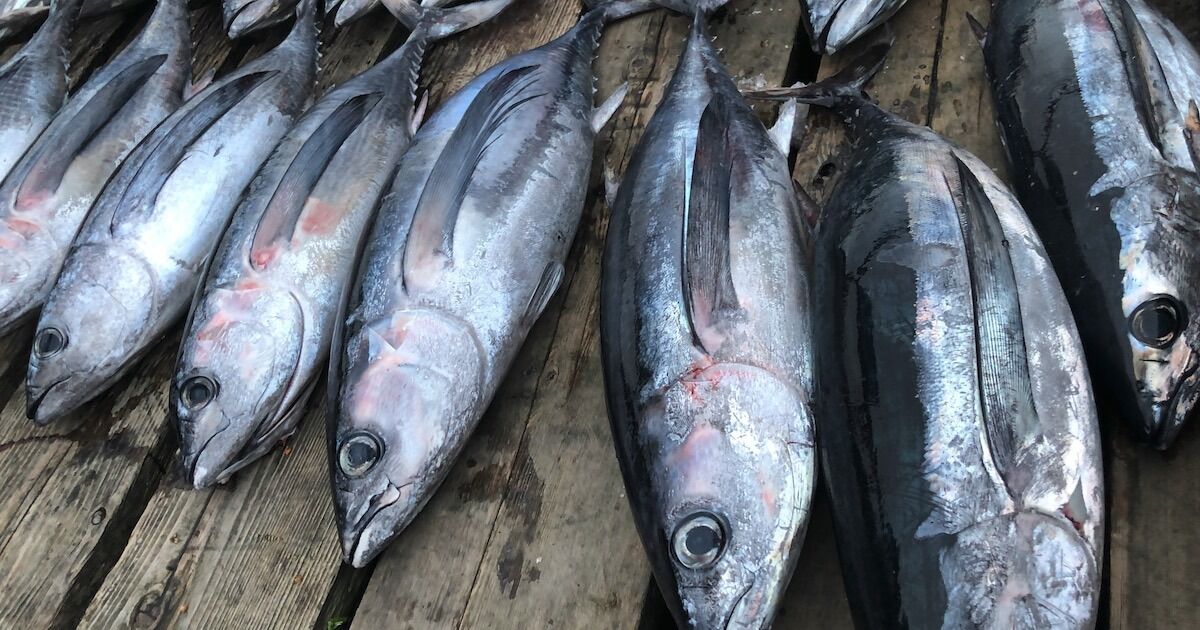
-
Latin Name: Thunnus alalunga
-
Phylum: Chordata
-
Class: Actinopterygii
-
Family: Scombridae
What Do Pacific Albacore Tuna Look Like?
Remember the old grade school riddle: “What’s the difference between a fish and a piano?” They both have scales, but “you can’t tuna fish!” It turns out the albacore doesn’t need it. It’s a fine- tuned swimming machine. If fish were cars, this sleek, powerful member of the mackerel family would be a Bugatti. Its metallic, muscular, torpedo-shaped body is built for speed, from its conical snout to its slender, white-edged tail. It’s one of the most compact members of the tuna family, reaching a maximum size of about 1.5 m and 50 kg. Its back is a deep navy blue, with an iridescent blue stripe down the side, fading to silvery-blue or white toward the belly. It has very large eyes, two dorsal fins, and two rows of 7 to 9 triangular finlets—one on top and one beneath— which resemble the spikes of a dragon’s tail. Also known as a longfin tuna, an albacore’s most distinctive characteristic is its exceptionally long, narrow set of pectoral fins, which extend about 30% of the total body length and help the albacore fly through the water. Hence, the scientific name, alalunga: ala means “wing” and lunga means “long.”
Albacore Tuna Credit: © lunamarina / Adobe Stock
Where Do Pacific Albacore Tuna Live?
There are six distinct stocks of albacore tuna in the world’s tropical and warmer temperate seas. Our Pacific variety gravitates to areas where warm and cold waters mix. It tolerates temperatures between 10° and 25°C, and ranges from depths of 600 m to the surface—usually less than 350 m deep.
What Moves Pacific Albacore Tuna?
These tuna get around with unparalleled efficiency, reaching speeds above 80 km/h. Albacore of similar size and age travel together—sometimes joined by skipjack, yellowfin, or bluefin—in enormous schools that can be up to 30 km wide. Many studies have shown that they routinely migrate across the equator between the North and South Pacific, and that juveniles (below 4 years of age) migrate annually from Japan to North America.
They have highly efficient circulatory systems, but lack the structures needed to pump oxygen-rich water over their gills. So, in order to breathe enough oxygen, they must always swim with their mouths open—never resting, constantly moving.
Pacific Albacore Tuna: Diet & Predation
The albacores’ impressive speeds make them apex predators. Only humans, toothed whales, and some larger species of billfish, sharks, rays, and tuna ever manage to catch them.
BC Albacore Tuna Sport Caught
To fuel its fiery metabolism each day, this tuna must eat about a quarter of its body weight in prey—primarily squid and other cephalopods. Crustaceans and fish—including sardine and anchovy— are secondary nutrition sources.
How Do Pacific Albacore Tuna Grow & Reproduce?
They “broadcast spawn” near the surface in late spring, in or near the tropics. Multiple males and females release sperm and eggs simultaneously, increasing the likelihood that eggs will get fertilized before being eaten by predators. It takes only about 48 hours for the fry to hatch. They grow rapidly and tend to remain near the spawning location for about a year before beginning their epic, trans-Pacific journeys. The few that survive to adulthood reach reproductive age at 5 or 6 years and live up to 12 years.
What are Pacific Albacore Tuna Known For?
Type “tuna” into a search engine, and the first three suggested searches will be foods—tuna casserole, tuna salad, tuna melt, etc. Tuna is almost synonymous with canned fish in North America. Odds are good it showed up in your lunchbox between some slices of bread when you were a kid. Albacore makes up about 30% of the canned tuna market.
But beware! Like other fish, albacore accumulate methylmercury in their tissues over time. Excess mercury exposure causes neurotoxic responses in humans, especially children. Fortunately, people can eliminate mercury from their tissues over the course of about a year. Unlike humans, however, fish have no natural processes to flush it from their systems. Larger, faster-growing fish— such as albacore—tend to contain higher levels of mercury. And the bigger the fish, the higher the concentration. Thus, it’s wise to keep the smaller ones, throw back the big ones, and limit consumption to a couple of servings per week. The good news is that mercury levels in our northern Pacific tuna are declining steadily, possibly due to a reduction in coal-fueled energy production.
The global tuna market generates at least $42 billion per year. A majority is netted via the “purse seine” method, but traditional pole-and-line tuna fishing is far more sustainable, because it eliminates by-catch of vulnerable creatures that travel the high seas with tuna. Catching your sandwich meat or sushi centre with an old-fashioned hook and reel just might help save an endangered seabird, shark, or turtle.
Click here for an in-depth article on tuna fishing in BC.
Visit the Store
$34.99
$34.99
Featured Catch
Joel Unickow halibut (Photo: Rob Frawley Lucky Strike Sportfishing Tofino)



